The quaint city of Prescott, nestled in Arizona’s central highlands, has long been admired for its unique architectural charm, a blend of native and colonial styles that tells a story of cultural integration and appreciation.
At the heart of this architectural tapestry is the influence of the Yavapai-Prescott tribe, whose traditional designs and motifs have become a defining feature of the city’s landscape.
Discover what we have in store! Visit our product page now for exclusive deals and must-have items. Don't miss out!

This article delves into how the Yavapai-Prescott tribe’s cultural influence has shaped Prescott’s architecture, creating a visually stunning and culturally rich environment that stands as a testament to the harmonious blending of different heritages.
Early Influences
Long before European settlers made their mark on Prescott, the Yavapai-Prescott tribe had developed a unique architectural style adapted to the region’s climate and landscape. Their structures, primarily made from natural materials like wood, stone, and clay, were not only functional but also held significant cultural meanings.
The arrival of European settlers introduced new materials and building techniques, which gradually influenced indigenous architecture. This period marked the beginning of a fusion between Yavapai-Prescott and European styles, laying the foundation for Prescott’s distinctive architectural character.
Cultural Convergence in Architecture
The integration of Yavapai-Prescott motifs in colonial buildings is a remarkable aspect of Prescott’s architecture. Intricate designs and patterns from the tribe’s traditional art were incorporated into the facades and interiors of colonial structures, symbolizing a respectful blending of cultures.
This collaboration wasn’t one-sided; the Yavapai-Prescott tribe also adopted some European architectural elements, resulting in a unique style that represented a true merging of cultural influences.
Materials and Techniques
The traditional building materials used by the Yavapai-Prescott tribe, such as adobe and native woods, played a pivotal role in shaping the region’s architectural identity. Their use of these materials demonstrated a deep understanding of the local environment and sustainability.
European building techniques, such as stone masonry and carpentry, were adopted and adapted by the Yavapai-Prescott tribe. This exchange of knowledge enriched both cultures’ architectural practices.
In recent times, modern materials have been incorporated into Prescott’s architecture, but always with a nod to the cultural significance and heritage of the Yavapai-Prescott tribe.
Iconic Structures
Several public buildings in Prescott showcase the Yavapai-Prescott tribe’s influence, with designs that blend traditional tribal motifs with modern architectural elements. These buildings serve as cultural landmarks and are a source of pride for both the tribe and the city.
Residential buildings in Prescott also reflect this cultural fusion. Many homes feature traditional tribal elements, such as natural wood beams and stone foundations, combined with modern comforts and aesthetics.
Places of worship in Prescott uniquely represent the fusion of Yavapai-Prescott and European architectural styles, symbolizing a broader blending of beliefs and cultures.
Architectural Motifs and Symbolism
Yavapai-Prescott architecture is rich in motifs that hold deep cultural significance. These include symbols of nature, like the sun and rain, which are often incorporated into building designs.
The symbolism in architectural elements extends beyond mere decoration, reflecting the tribe’s beliefs and values. For instance, circular patterns may represent the cycle of life, a central theme in Yavapai-Prescott culture.
Landscape and Urban Planning
The influence of the Yavapai-Prescott tribe extends to the urban layouts of Prescott. The city’s design respects the natural landscape, mirroring the tribe’s philosophy of living in harmony with nature.
Parks and public spaces in Prescott often incorporate elements of Yavapai-Prescott culture, serving as open-air galleries where residents and visitors can appreciate the tribe’s artistic and architectural heritage.
Preservation and Restoration Efforts
Preservation efforts in Prescott have focused on maintaining the integrity of structures influenced by indigenous architecture. These efforts ensure that the rich history and cultural significance of these buildings are preserved for future generations.
Modern restoration projects often involve repurposing historic buildings while retaining their cultural essence. This approach not only preserves the past but also adapts it to contemporary needs, showcasing the dynamic nature of Prescott’s architectural heritage.
Architects and Visionaries
Several architects have been instrumental in blending Yavapai-Prescott and European styles, creating some of Prescott’s most iconic buildings. Their work demonstrates a deep respect for cultural traditions while pushing the boundaries of modern architecture.

The contribution of Yavapai-Prescott craftsmen, with their traditional techniques and knowledge, has been vital in preserving the tribe’s architectural influence. Their skills have been passed down through generations, keeping the tribe’s artistic legacy alive.
Community and Architecture
In Prescott, housing and community layouts reflect a blend of Yavapai-Prescott and European influences, creating neighborhoods that are both culturally rich and aesthetically diverse.
The local community plays a crucial role in preserving Prescott’s architectural heritage. Community-led initiatives and organizations work tirelessly to maintain the city’s unique cultural landscape.
Education and Promotion
Educational programs in Prescott aim to raise awareness about the importance of preserving cultural architecture. These programs, often held in local schools and community centers, highlight the history and significance of the Yavapai-Prescott tribe’s influence.
Museums and exhibitions in Prescott offer detailed insights into the tribe’s architectural influence. These venues provide a platform for learning and appreciating the cultural richness of Prescott’s architecture.
Challenges and Controversies
One of the main challenges in Prescott’s architectural development is balancing modernization with the preservation of cultural integrity. This delicate balance is crucial for maintaining the city’s unique character.
Legal and ethical considerations often come into play when incorporating indigenous elements into new designs. It’s important to ensure that these cultural influences are used respectfully and appropriately.
Comparative Analysis
Comparing the Yavapai-Prescott tribe’s influence with that of other indigenous groups provides a broader understanding of how native cultures have shaped American architecture.
A global perspective reveals similar instances of cultural architectural integrations worldwide, demonstrating a universal appreciation for blending different architectural traditions.
Economic Impact
Prescott’s unique architecture, heavily influenced by the Yavapai-Prescott tribe, is a significant draw for tourists. This influx of visitors has a positive economic impact on the city.
Preserving cultural heritage through architecture also has broader economic benefits, including job creation in restoration projects and increased property values in areas with culturally significant buildings.
Future Trends and Predictions
Emerging trends in cultural architecture indicate a growing interest in integrating traditional elements into modern designs. This approach ensures that cultural influences continue to evolve and remain relevant.
The future of the Yavapai-Prescott tribe’s influence in Prescott’s architecture looks promising, with increasing recognition of the value of cultural diversity in architectural design.
Societal Impact
Architecture in Prescott serves as a powerful tool for cultural education, providing tangible insights into the history and heritage of the Yavapai-Prescott tribe.
By showcasing the tribe’s influence in the city’s architecture, Prescott fosters a deeper understanding and appreciation of different cultures, contributing to a more inclusive society.
Environmental Considerations
Sustainability is a key aspect of Yavapai-Prescott-inspired architecture, with many buildings designed to be environmentally friendly and energy-efficient, reflecting the tribe’s traditional values of respecting and preserving nature.
The incorporation of eco-friendly practices and traditional knowledge in modern architecture highlights the tribe’s longstanding commitment to environmental stewardship.
Personal Stories and Anecdotes
The personal journeys of architects who have contributed to Prescott’s unique architectural landscape are filled with inspiration and dedication. Their stories often reflect a deep appreciation for the Yavapai-Prescott tribe’s culture and a commitment to integrating it into their work.
Community members in Prescott have personal connections to the city’s cultural architecture, often recounting stories of how these buildings have played a role in their lives and reflecting the community’s strong bond with its architectural heritage.

These stories add a human element to the buildings, making them more than just structures but rather integral parts of people’s lives and histories.
FAQs: Yavapai-Prescott tribe’s Cultural Influence on Prescott Architecture
What are the key features of Yavapai-Prescott-influenced architecture?
The key features include the use of natural materials, the incorporation of tribal motifs and symbols, and a design ethos that respects the natural landscape and cultural heritage.
How has the Yavapai-Prescott tribe contributed to contemporary architecture?
The tribe has contributed through the incorporation of traditional design elements and sustainable building practices, influencing modern architectural trends toward cultural sensitivity and environmental stewardship.
What challenges face the preservation of this cultural architecture?
Challenges include balancing modernization with cultural integrity, navigating legal and ethical considerations, and ensuring adequate funding and community support for preservation efforts.
How can individuals learn more about Yavapai-Prescott’s architectural influence?
Individuals can visit local museums, participate in community-led educational programs, and explore Prescott’s architecture through guided tours that focus on the tribe’s influence.
Conclusion
Prescott, Arizona, stands as a shining example of how architecture can serve as a bridge between cultures, celebrating the rich heritage of the Yavapai-Prescott tribe while embracing modern design principles.
The city’s buildings tell a story of mutual respect, collaboration, and admiration between the Yavapai-Prescott tribe and other cultural influences.
As we move forward, the lessons learned from Prescott’s architectural journey can guide us in creating more culturally inclusive and environmentally sustainable spaces, proving that architecture is not just about buildings, but about the stories they tell and the communities they serve.



Leave a Comment
You must be logged in to post a comment.